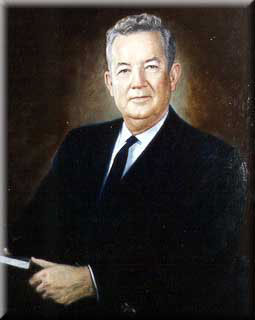Table of contents:
Senator Heflin's remarks on Senator John Sparkman as recorded in the
Congressional Record.
View photos of Senator Sparkman.
Senator John Sparkman
Senator John Jackson Sparkman was born near Hartselle, Alabama, on December 20, 1899. He earned numerous degrees from the University of Alabama and a degree from Auburn University. He married the former Ivo Hall and had one daughter, Julie Ann (Mrs. Tazewell T. Shepard, Jr.).
Senator Sparkman began his career as a lawyer in Huntsville from 1925 to 1937. Elected to represent the 8th Congressional District in 1936, he was instrumental in encouraging the U.S. Army to locate a chemical munitions plant near Huntsville in 1941 that would be named Huntsville Arsenal. Later that same year, the Army located a shell loading and manufacturing plant named the Redstone Ordnance Plant adjacent to Huntsville Arsenal.
Congressman Sparkman tours Redstone Arsenal facilities during WWII with Colonel Carroll D. Hudson, first Redstone commander Throughout World War II, Sparkman took a personal interest in Redstone Arsenal. When the Army implemented plans to turn operations at Redstone Arsenal over to a contractor, Sparkman interceded on behalf of the employees of Redstone Arsenal, convincing the Army that government employees would work harder for the Army than a contractor. Sparkman was right. Employees of Redstone Arsenal won the Army-Navy E Award (for outstanding production in war equipment) five different times. When additional housing was needed for the arsenal complex, Sparkman introduced legislation to fund it.
Elected to the U.S. Senate in 1948, Sparkman once again played an influential role in convincing the Army to consolidate its new missile and rocket research efforts at Redstone Arsenal. In later years, he visited Redstone often, always supportive of the Army's efforts in the field of missilery. But Sparkman's interest in the Army was not limited to Redstone Arsenal. He is credited with writing four of the most important pieces of legislation to benefit service members and veterans: the GI Bill of Rights, the Korean Veterans Act, the GI Bill for Vietnam Veterans, and the Soldiers and Sailors Relief Act. 11 December 1956: Senator Sparkman tours missile facilities, seen here with MG Holger N. Toftoy (far left) and MG John B. Medaris (far right)
1977: Senator Sparkman aims a VIPER Senator Sparkman completed 42 continuous years of service in Congress in January 1979. He died on November 19. 1985. In gratitude for his continued support of Redstone Arsenal from its beginning until the time of his death, the Army named its new administrative office complex on Redstone Arsenal the "John J. Sparkman Center." Senator Howell Heflin called the Center a "dynamic and living memorial to a great Alabamian." (Complete text of Senator Heflin's remarks as recorded in the Congressional Record.
Congressional Record excerpt from Senator Howell Heflin on the dedication of the Sparkman Complex -
DEDICATION OF THE JOHN J. SPARKMAN CENTER FOR MISSILE EXCELLENCE

|
(Senate - September 20, 1994) [Page: S12984] Mr. HEFLIN. Madam President, the John J. Sparkman Center for Missile Excellence at Redstone Arsenal was formally dedicated on August 22. The Sparkman Center consolidates and houses the Missile Command that manages the missile material mission for the Army, as well as other functions located at Redstone. I was deeply gratified to see this complex completed and functional, not only for what it means to our national security, the U.S. Army, and the State of Alabama's future, but because of the fitting honor it bestows upon the memory of the late Senator John J. Sparkman . |
Huntsville was, of course, John Sparkman 's home, and he would be very proud of the way his city continues to grow and lead the Nation in advanced technology innovation and research. Throughout his more than 42 years in Congress, he was the driving force in making Huntsville the leading research and scientific center that it has become. The fact that Redstone Arsenal and NASA's Marshall Space Flight Center are located there is due in large part to his strong leadership. Indeed, he did so very much for this vibrant city in so many ways.
John Sparkman was born in 1899, in an unpretentious tenant farm home near Hartselle. One of 11 children, he learned the traditional American values of hard work, religious faith, and eagerness to learn at a young age. He used the proceeds from the sale of a cotton crop he had grown himself to enroll at the University of Alabama, where he planned to study to be a schoolteacher.
While earning his bachelor, master, and law degrees, John Sparkman was awarded a teaching fellowship in history and political science, served as editor of the student newspaper, and was elected president of the student government.
In 1936, after practicing law in Huntsville for a number of years, John Sparkman was elected to the U.S. House of Representatives. During his five terms in the House, he served on the Military Affairs Committee, which was particularly crucial during World War II and to the development of Redstone Arsenal. In his last term, he served as majority whip.
In 1946, Congressman Sparkman was confronted with a rather unique situation. After he easily received the Democratic nomination for an expected sixth term in the House, the death of Senator John Bankhead, Jr. created a vacancy in the Senate. John decided to seek that vacant seat, and won the primary vote over two formidable opponents without a runoff. In the general election, his name appeared as the Democratic candidate for both the Senate and House seats. I know of no other American political figure who has been elected to the Senate and the House on the same day and the same ballot.
In his early days in the Senate, one of John Sparkman 's primary legislative interests was the Nation's small businesses. As the first chairman of the Senate Select Committee on Small Business, and the chief sponsor of the legislation creating the Small Business Administration, Senator Sparkman helped to establish an economic climate favorable to small businesses.
In his last term, Senator Sparkman assumed the role of chairman of the Committee on Foreign Relations. As chairman, he worked to alleviate the major health problems of the world. Earlier, as a committee member, he had been a key leader in the establishment of both NATO and of the Marshall plan. In 1950, he was the U.S. representative to the Fifth General Assembly of the United Nations. He strongly advocated bipartisan cooperation in the foreign affairs.
Additionally, he was instrumental in the passage of laws dealing with education, crop insurance, veterans' benefits, and the Tennessee Valley Authority. He once said that of all his accomplishments, he was most proud of his work to pass the Rural Electrification Act, which carried electric lights and other electrical uses to the outlying rural areas of the country and brought progress to every corner of the land. He also served as cochairman of the Joint Defense Production Committee for several Congresses.
Long before his seniority won him the chairmanship of the Committee on Banking, Housing, and Urban Affairs, he had become known as `Mr. Housing.' He believed that homeownership should be the attainable goal of every American family, and that the Federal Government should foster, encourage, and assist them in reaching this goal. He was the primary craftsman of almost all public housing legislation, beginning with the Housing Act of 1949, which began the Nation's Urban Renewal Program.
The millions of homes built under Federal Housing Programs were built largely because of Senator Sparkman 's leadership, dedication, and commitment, and stand as a fitting and proper tribute to his work. The Sparkman Center is a welcome addition to his housing legacy, as it will house one of the army's most important functions.
During the 1950's and 1960's, one of the major issues that, of course, confronted Senator Sparkman was civil rights. In 1948, the Democratic Party in Alabama came under the control of the Dixiecrats and split from the national party. John Sparkman refused to go along. Not only did he keep his allegiance to the national party, he also successfully fought the Dixiecrats for control of the State party thereafter for a number of years. Throughout the civil rights struggle, John Sparkman was a southerner who was recognized as being a voice of reason, progress, and moderation.
In 1952, yet another testimonial to his outstanding abilities was paid when the Democratic National Convention selected him as its Vice Presidential nominee. Unfortunately, the Stevenson-Sparkman ticket was up against a man who was perhaps the most formidable adversary possible at that time--Gen. Dwight Eisenhower. The defeat he suffered that year would be the only electoral loss John Sparkman ever experienced, as he went on to four more successful Senate races.
Many of my present colleagues in the Senate who served with him remember John Sparkman as a leader who stood for and supported enhanced educational and professional training opportunities for all citizens. It is entirely fitting that this new complex at Redstone is named for him. Such a dynamic, living memorial is the only kind appropriate for a man whose most basic instincts resonated with a vigorous orientation toward the promise of the future.
In many ways, John Sparkman 's life and career demonstrated both the opportunity which America provides and the progress we as a Nation made during the more than 85 years that he lived. He served in Congress longer than any other Alabamian--through the Great Depression, World War II, the Korean conflict, the war in Vietnam, the social discord of the civil rights struggle--much of which was centered in his home State--and the resignation of a President. We can all learn something from reflecting upon his life and times.
I am proud and excited that this living memorial to a great Alabamian and American--the John J . Sparkman Center for Missile Excellence--has now become a reality. The center will prove instrumental in guiding our national security, the U.S. Army, and Huntsville into the next century, and will live on as a testament to the life and work of one of our most outstanding public servants.

John Sparkman at his desk |
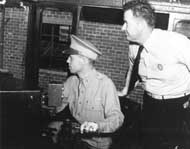
Congressman Sparkman tours Redstone Arsenal facilities during WWII with Colonel Carroll D. Hudson, first Redstone commander |

11 December 1956: Senator Sparkman tours missile facilities, seen here with MG Holger N. Toftoy (far left) and MG John B. Medaris (far right) |

1977: Senator Sparkman aims a VIPER |
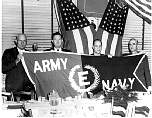 Sparkman E Award |
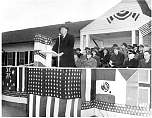 Sparkman E Award |
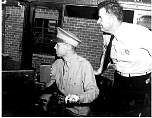 Sparkman Hudson |
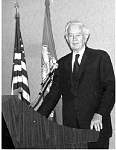 Sparkman |
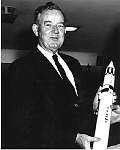 Sparkman |
 Sparkman |
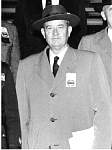 Sparkman |
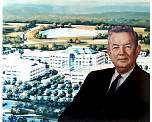 Sparkman |
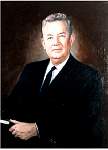 Sparkman |
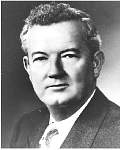 Sparkman |
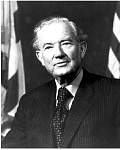 Sparkman |
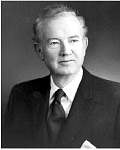 Sparkman |
 Sparkman 1940 |
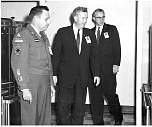 Sparkman 1958 |
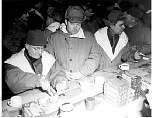 Sparkman in Korea |
 Sparkman Medaris von Braun |
 Sparkman Redstone |
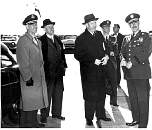 Sparkman Toftoy Medaris |
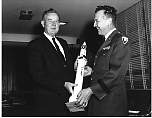 Sparkman Zierdt |
